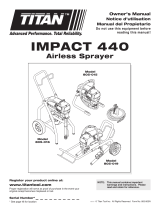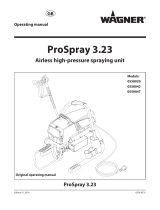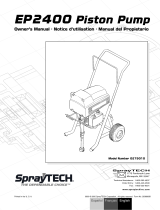
4 ProSpray 3.21
GB
Safety Regulations
1. Safety regulations for Airless spraying
1.1 Explanation of symbols used
This manual contains information that must be read and understood
before using the equipment. When you come to an area that has one
of the following symbols, pay particular attention and make certain
to heed the safeguard.
This symbol indicates a potential hazard that
may cause serious injury or loss of life. Important
safety information will follow.
tention
This symbol indicates a potential hazard to you
or to the equipment. Important information that
tells how to prevent damage to the equipment or
how to avoid causes of minor injuries will follow.
Danger of skin injection
Danger of fire from solvent and paint fumes
Danger of explosion from solvent, paint fumes
and incompatible materials
Danger of injury from inhalation of harmful
vapors
Notes give important information which should
be given special attention.
HAZARD: INJECTION INJURY
Attention: Danger of injury by injection! A high
pressure stream produced by this equipment can
pierce the skin and underlying tissues, leading to
serious injury and possible amputation.
Do not treat a spraying injury as a harmless cut. In
case of injury to the skin through coating materials
or solvents, consult a doctor immediately for quick
and expert treatment. Inform the doctor about the
coating material or solvent used.
PREVENTION:
• NEVERaimthegunatanypartofthebody.
• NEVERallowanypartofthebodytotouchtheuidstream.
DO NOT allow body to touch a leak in the uid hose.
• NEVERputyourhandinfrontofthegun.Gloveswillnot
provide protection against an injection injury.
• ALWAYSlocktheguntrigger,shuttheuidpumpoand
release all pressure before servicing, cleaning the tip guard,
changing tips, or leaving unattended. Pressure will not be
releasedbyturningotheengine.ThePRIME/SPRAYvalve
or pressure bleed valve must be turned to their appropriate
positions to relieve system pressure.
• ALWAYSkeeptipguardinplacewhilespraying.Thetipguard
provides some protection but is mainly a warning device.
• ALWAYSremovethespraytipbeforeushingorcleaningthe
system.
• NEVERuseaspraygunwithoutaworkingtriggerlockand
trigger guard in place.
• Allaccessoriesmustberatedatorabovethemaximum
operating pressure range of the sprayer. This includes spray
tips, guns, extensions, and hose.
HAZARD
: HIGH PRESSURE HOSE
The paint hose can develop leaks from wear, kinking
and abuse. A leak can inject material into the skin.
Inspect the hose before each use.
PREVENTION:
• High-pressurehosesmustbecheckedthoroughlybeforethey
are used.
• Replaceanydamagedhigh-pressurehoseimmediately.
• Neverrepairdefectivehigh-pressurehosesyourself!
• Avoidsharpbendsandfolds:thesmallestbendingradiusis
about 20 cm.
• Donotdriveoverthehigh-pressurehose.Protectagainst
sharp objects and edges.
• Neverpullonthehigh-pressurehosetomovethedevice.
• Donottwistthehigh-pressurehose.
• Donotputthehigh-pressurehoseintosolvents.Useonlya
wet cloth to wipe down the outside of the hose.
• Laythehigh-pressurehoseinsuchawayastoensurethatit
cannot be tripped over.
Only use WAGNER original-high-pressure hoses in
order to ensure functionality, safety and durability.
HAZARD: EXPLOSION OR FIRE
Solvent and paint fumes can explode or ignite.
Severe injury and/or property damage can occur.
PREVENTION:
• Donotusematerialswithaashpointbelow21°C(70°F).
Flashpoint is the temperature at which a uid can produce
enough vapors to ignite.
• Donotusetheunitinworkplaceswhicharecoveredbythe
explosion protection regulations.
• Provideextensiveexhaustandfreshairintroductionto
keep the air within the spray area free from accumulation of
ammable vapors.
• Avoidallignitionsourcessuchasstaticelectricitysparks,
electrical appliances, ames, pilot lights, hot objects, and
sparks from connecting and disconnecting power cords or
working light switches.
• Donotsmokeinsprayarea.
• Placesprayersucientdistancefromthesprayobjectina
well ventilated area (add more hose if necessary). Flammable
vapors are often heavier than air. Floor area must be
extremely well ventilated. The pump contains arcing parts
that emit sparks and can ignite vapors.
• Theequipmentandobjectsinandaroundthesprayareamust
be properly grounded to prevent static sparks.
• Useonlyconductiveorearthedhighpressureuidhose.Gun
must be earthed through hose connections.
• Powercordmustbeconnectedtoagroundedcircuit(electric
units only).
• Alwaysushunitintoseparatemetalcontainer,atlowpump
pressure, with spray tip removed. Hold gun rmly against side
of container to ground container and prevent static sparks.






















